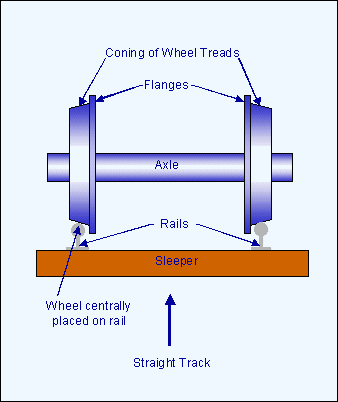We have traveled thousands of kilometers in trains, but we haven’t given a thought about how do trains turn during a curved path ? Both the wheels are connected through an axle & obviously are of same diameter. But,when a train takes turn, the outer wheel has to cover more distance than the inner one…! How is this possible ? How can the outer wheel cover more distance than the inner one even when both the wheels have same diameter ??? 🙁
How do trains turn –
The solution is simple & elegant.
Both the wheels are a bit flanged OR conicle. The part having greater diameter of the frustum of the conical wheels is inward while of lesser diameter are outwards the track.
Now whenever a trains travel on a curved track, the wheels get slide away in either of the direction.
The following happens while taking a turn –
- Suppose the train is taking a left turn(as in the above picture). Which means the wheels will slide to the right(→) side, obviously due to centrifugal force.
- The outward force-centrifugal force results in increment of diameter of right wheel(↑) & decrement of left wheel(↓) during the turn(the black line on wheels in the above image).
- The right wheel covers more distance than the left wheel since the right one has greater diameter than the left one & hence the problem gets solved ! 🙂
Also it solves one more major problem. Whenever there is a bump on tracks, the wheels suddenly slide even when travelling on a straight track & there is a great danger of being derailed, so the same design helps to stabilize the train & to run smoother.
Here is a video which will help you to understand it better.
In engineering,
The most simple designs are considered as the best solutions !
So besides the working, what we also learn is that – It isn’t necessary every time to make complex machines & design complex mechanisms, all it takes is a simple design of the thing what we already have.
You might like –



